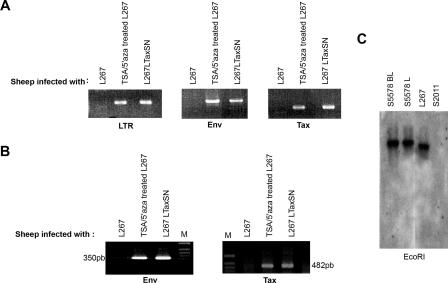FIG. 3.
TSA/5′azacytidine treatment of L267 cells results in the rescue of an in vivo infectious and oncogenic virus. (A and B) PCR and RT-PCR analysis of BLV-specific sequences in PBMCs isolated from sheep injected with L267 cells, TSA/5′azacytidine (TSA/5′aza)-treated L267 cells, and L267LTaxSN cells 90 days postinoculation. (A) Proviral DNA was amplified using the LTR-, tax-, and env-specific primers. (B) RT-PCR using two sets of splice-specific primers, LTR-R/EnvC and EnvA/Tax2, for the detection of the singly (env) and doubly (tax) spliced BLV transcripts, respectively. (C) Southern blotting analysis of EcoRI-restricted genomic DNA extracted from PBMCs and lymphoid tumors collected from TSA/5′azacytidine-treated L267-injected sheep S5578 20 months after inoculation (S5578 BL and S5578 L, respectively), PBMCs from sheep injected with the silent L267 parental cell line (S2011), and DNA extracted from the parental L267 cell line. A 32P-labeled BLV full-length proviral DNA probe was used for hybridization in gels shown in panels A, B, and C. Positions of primers are depicted in Fig. 1A.

